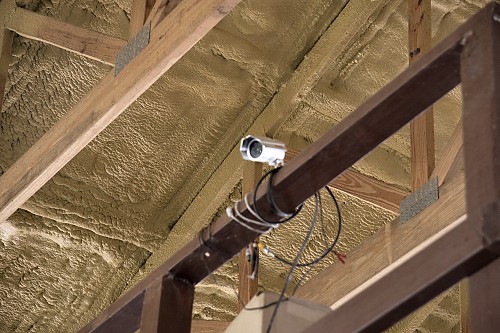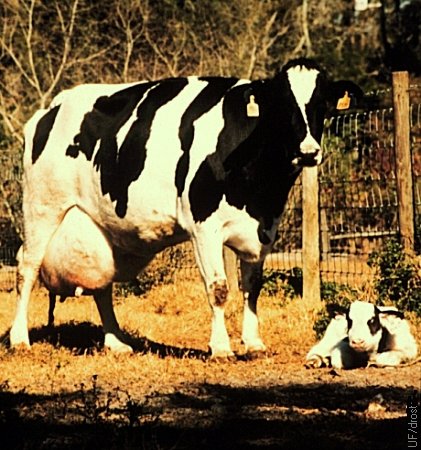The Visual Guide to
Bovine Reproduction
- Normal Calving
- Multiple Births
- Calving Facilities
- Pelvic Dimensions
- Calving Problems
- True Breech
- Sizing the Fetus
- Calving Injuries
- Cesarean Section
- Fetotomy
- Pelvic Splitting
- Episiotomy
Obstetrics: Calving Facilities
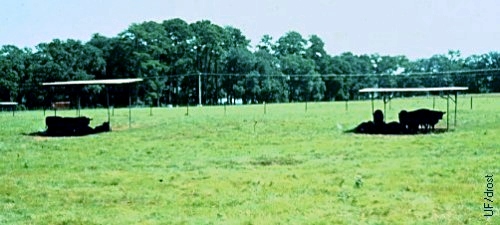
Calving Pasture.
Ideally, during the right season of the year, cows should calve out on pasture. There should be shade and no bodies of low standing water in which the calf can drown. A catch pen is essential if assistance needs to be provided. The latter should be equipped with a source of clean water, cover against the weather and a light source for night time deliveries. The pasture should be large enough to keep it from becoming a contaminated mud hole with repeated use.
Drost M (2009)
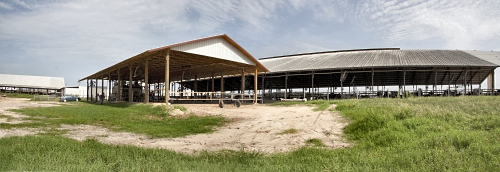
Maternity Barn.
Maternity barn in Florida, in a semi-tropical climate. Protection against the sun and the rain. The calving pen and obstetrical facilities are housed in the barn on the left. The large barn on the right is a standard free stall barn.
Bennink DL (2010)
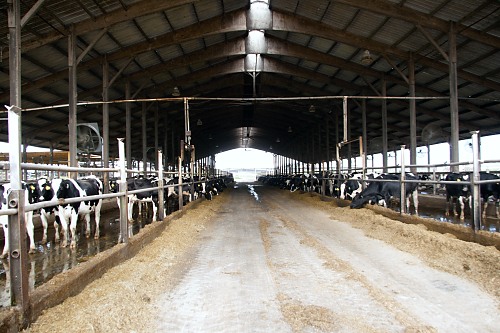
Freestall Barn.
Maternity barn in Florida, in a semi-tropical climate, offering protection against the sun and the rain. Large fans and sprinklers or misters are in place to minimize heat stress.
Bennink DL (2010)
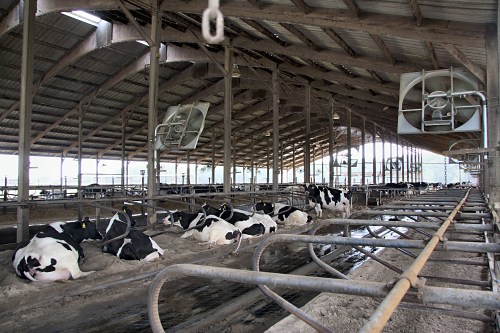
Freestalls.
on large farms free stalls can be designed to facilitate 24-hour observation with construction of two-row head-to-tail arrangements. Hindquarters of all cows are visible from the central isle.
Bennink DL (2010)

Udder Development.
Distended udder and turgid teats, signs of impending parturition.
Bennink DL (2010)
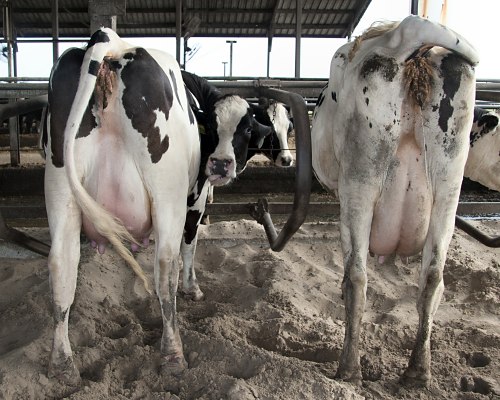
Signs of Impending Parturition.
Distended udder and turgid teats. The cow on the right shows a string of clear mucus. Cows are due to calve within 2 to 3 days.
Bennink DL (2010)

Calving Pen.
When two feet of the calf are visible cows are moved to the calving pen. The bedding is sand. Note the elevated tail. Moving cows earlier than that may delay the active calving process as the stressed cow searches for her herd mates.
Bennink DL (2010)
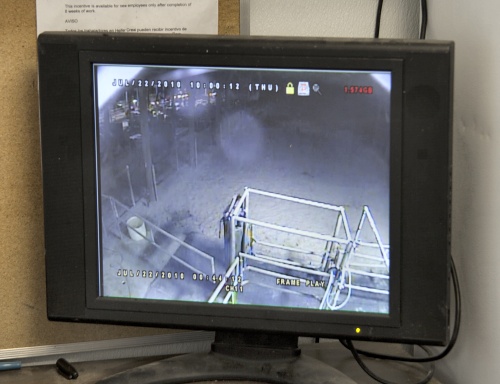
Monitoring Screen.
The calving pen is monitored around the clock. Monitors can be placed in several locations.
Bennink DL (2010)
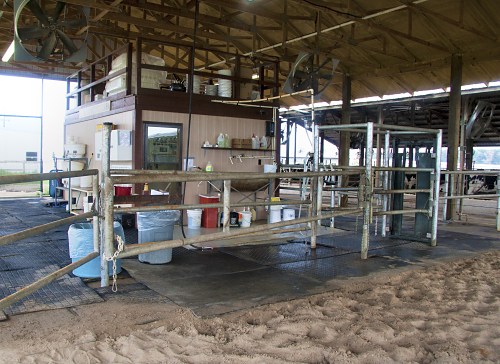
Delivery Chute.
Overview of the delivery chute adjacent to the calving pen. The area is protected against the sun and rain, and can be lit up at night. Water, soap and lubrication are readily available.
Bennink DL (2010)
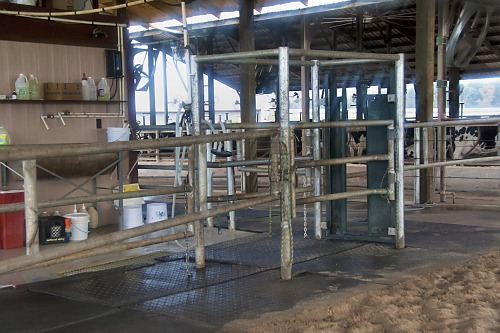
Delivery Chute - Close-Up.
The calving chute has a vertical head gate, which avoids choking when the cow goes down. The sides panels are hinged near the head gate and can swing open. Rubber mats offer protection if the cows goes down, or has to be cast. A water hose is suspended at the back of the chute.
Bennink DL (2010)
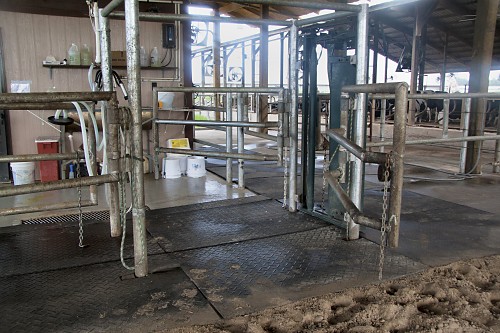
Side Opening Gates.
The calving chute has a vertical head gate. The sides panels are hinged near the head gate and can swing open. Rubber mats offer protection if the cows goes down or has to be cast. A water hose is suspended at the back of the chute.
Bennink DL (2010)

Cow in Stanchion.
The calving stanchion is placed at the edge of the calving pen. Nearby free stalls are shown in the background. A large fan is overhead.
Bennink DL (2010)
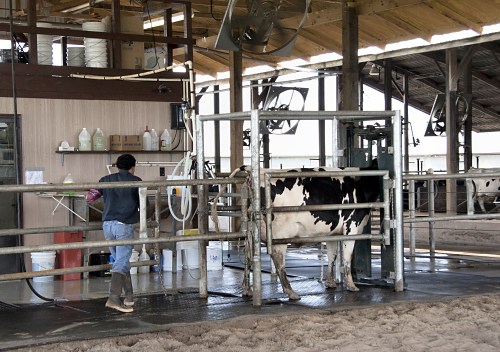
Cow in Stanchion - Close-Up.
The calving stanchion is placed at the edge of the calving pen. Large fans are overhead. A water hose is hooked up. A milking machine is ready.
Bennink DL (2010)
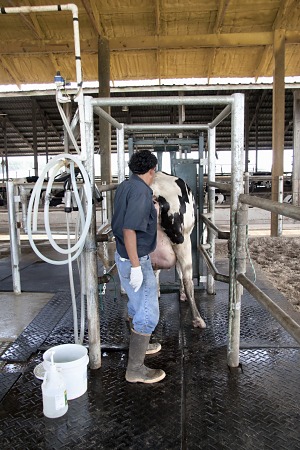
Examination of a Cow in Labor.
Two feet were showing. The calf is now examined for presentation, position, and posture, as well as whether it is alive or not.
Bennink DL (2010)
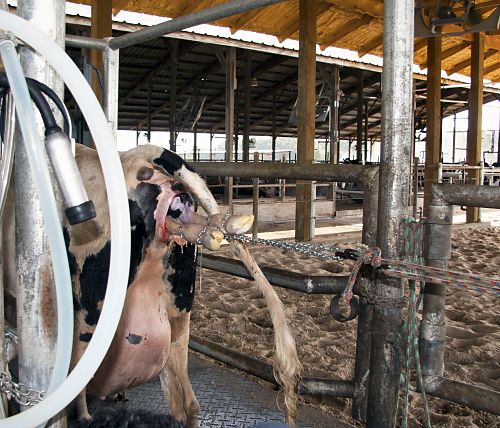
Muzzle Is Showing.
Two feet were showing. After some traction by one person, the muzzle is now also showing. There will be enough room if both pasterns can be pulled 15 cm beyond the lips of the vulva (as is the case here).
Bennink DL (2010)
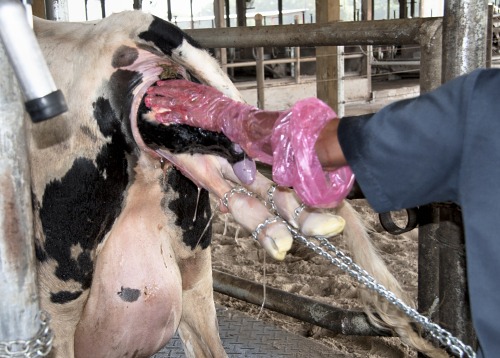
Cow Standing During Delivery.
The calf is being delivered with the cow standing. If the cow goes down, the side gates can be swung open, and the cow can be positioned on her right side on the rubber mat.
Bennink DL (2010)

Cow Is Trying To Go Down.
The cow is starting to go down. To be safe she should be cast on her right side on the rubber mat. The calf should be rotated to facilitate passage of the hips through the pelvic inlet.
Bennink DL (2010)
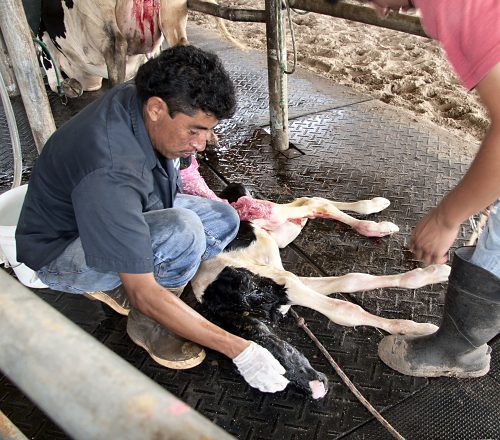
Check The Calf For Respiration.
As soon as the calf has been delivered it must be checked to see if it is breathing. The nostrils should be cleared and the head and neck should be extended.
Bennink DL (2010)
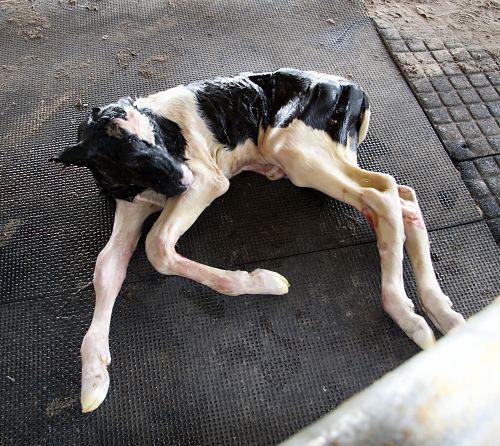
Is The Calf Breathing?
The calf is alive. It is able to raise its head. It should be placed on its chest to make it easier to breathe.
Bennink DL (2010)
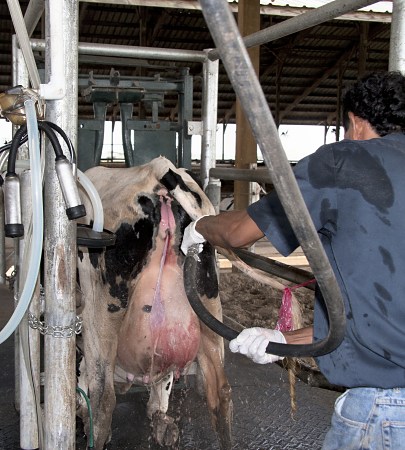
Check For A Twin.
After a calf has been delivered the cow should be checked for the presence of another calf. The vulva and the tail should be washed off before inserting a clean, well lubricated hand and arm into the birth canal.
Bennink DL (2010)
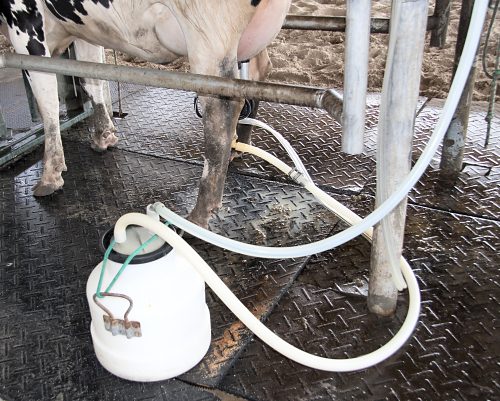
Check For Colostrum.
Before the cow is released the udder should examined for the presence and quality of the colostrum. The colostrum should then be milked out (on dairy farms).
Bennink DL (2010)
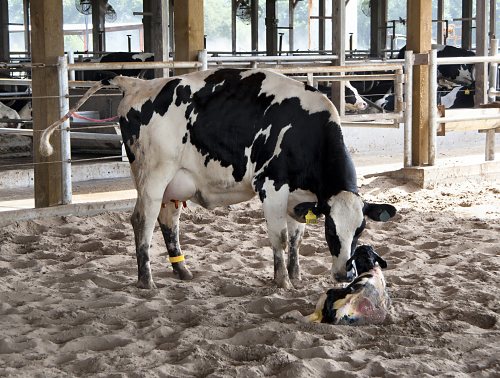
Cow And Calf After Delivery.
Licking her calf stimulates the cow to release oxytocin which aids in milk letdown and uterine contractions. This in turn facilitates expulsion of the fetal membranes and involution of the uterus.
Bennink DL (2010)
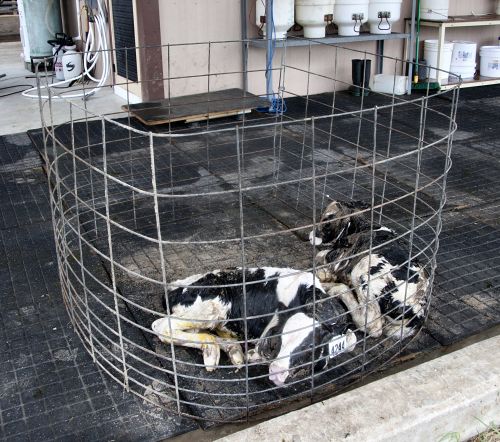
Neonates.
Neonates in a temporary holding pen are awaiting their initial colostrum feeding and subsequent transportation to the individual calf pens in the nursery.
Bennink DL (2010)
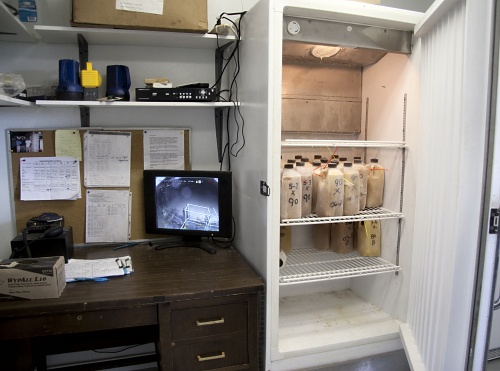
Colostrum Bank.
Fresh colostrum is in the refrigerator. A back up supply of colostrum is also maintained in a freezer.
Bennink DL (2010)

Maternity Barn.
Clean supplies: buckets for the milking machine on the left rack; esophageal tube feeders on the right suspended under the cabinet; chains, handles, soap and lubricant in the cabinet; a dispensing jar of lubricant on the right; buckets for disinfectant solution in the center.
Bennink DL (2010)
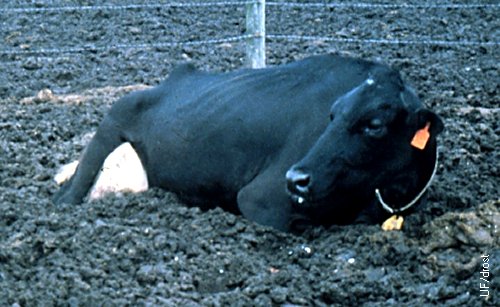
Dirty Maternity Area.
An over-used mud lot is a bad calving area. Poor hygiene at calving results in uterine infections and delayed involution. Cleanliness and lubrication are the hallmarks of good obstetrical care.
Drost M (1978)
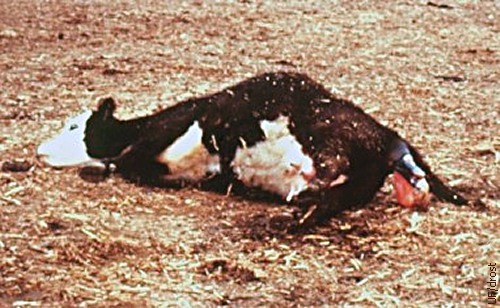
Dirty Calving Area.
Cleanliness and lubrication are the hallmarks of good obstetrical care. This is not a good area, especially when used repeatedly.
Drost M (1978)

Excessive Traction.
Forceful traction with mechanical aids is risky and may cause serious injuries to the calf and the dam. Guidelines outlined in the calving plan should be followed before extraction is started. This is no place and time for trial and error. Cleanliness and lubrication are the hallmarks of good obstetrics.
Drost M (1978)
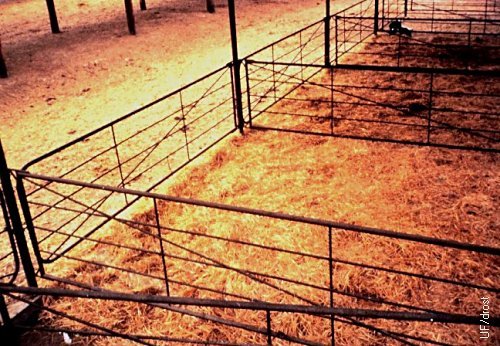
Maternity Pen.
A designated calving area that is cleaned after each use is essential on large drylot dairy farms. The pen should be easily accessible for cleaning equipment via large swinging gates.
Risco CA (1984)
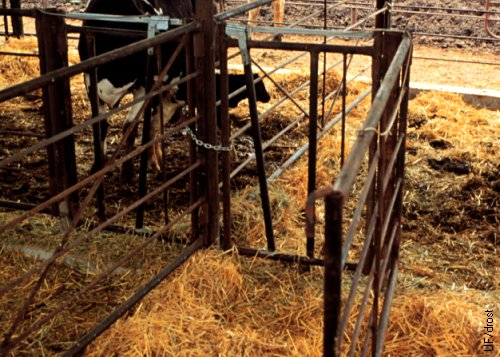
Head Catch in Maternity Pen.
Each maternity pen or facility should have a head catch to restrain the animal for examination prior to actual delivery. Swinging gates should be provided as cows generally lie down during the actual delivery.
Risco CA (1984)
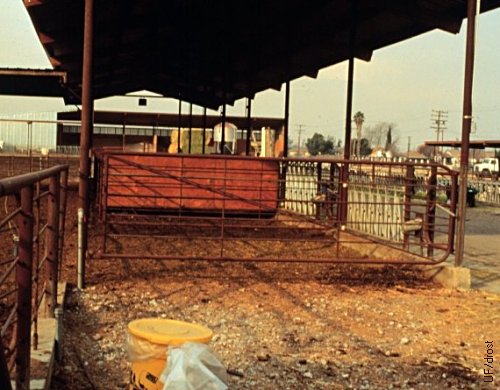
Easy to Clean Maternity Pen.
A trash can with a lid is important to get rid of the fetal membranes and to minimize flies. Cleanliness is next to godliness.
Risco CA (1984)
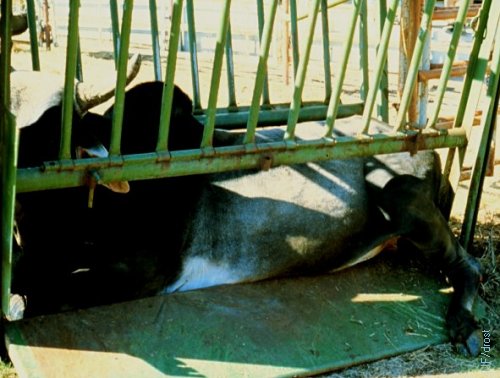
Down in the Chute.
Calves should never be delivered with the cow restrained in a chute, with possible exception of a side opening chute. Calving heifers or cows invariably go down during the actual delivery. Cows may be examined in the chute prior to delivery. A halter may then be put on and tied low and long to the front of the chute after which the cow is released and can be worked on in front of the chute.
Drost M (1981)
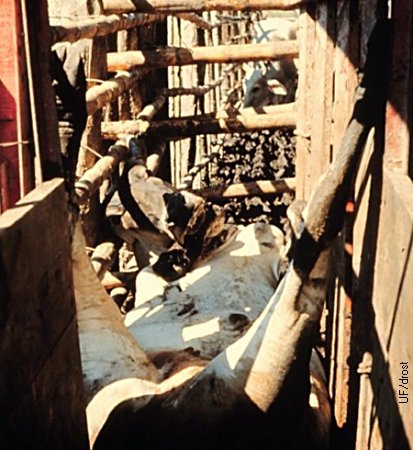
Down in the Lane.
Attempting to deliver a calf in a lane is a ticket to disaster. The lane may be used to place a halter on the cow or heifer which is then tied long and low to the end of the lane and the animal is let out. Once work is started on the calf the animal invariably concentrates on the efforts of labor, rather than on fighting the restraint.
Drost M (1981)
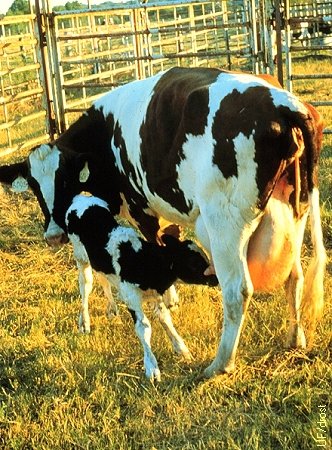
First Nursing.
Red Holstein heifer with newborn calf attempting to nurse.
Drost M (1983)

